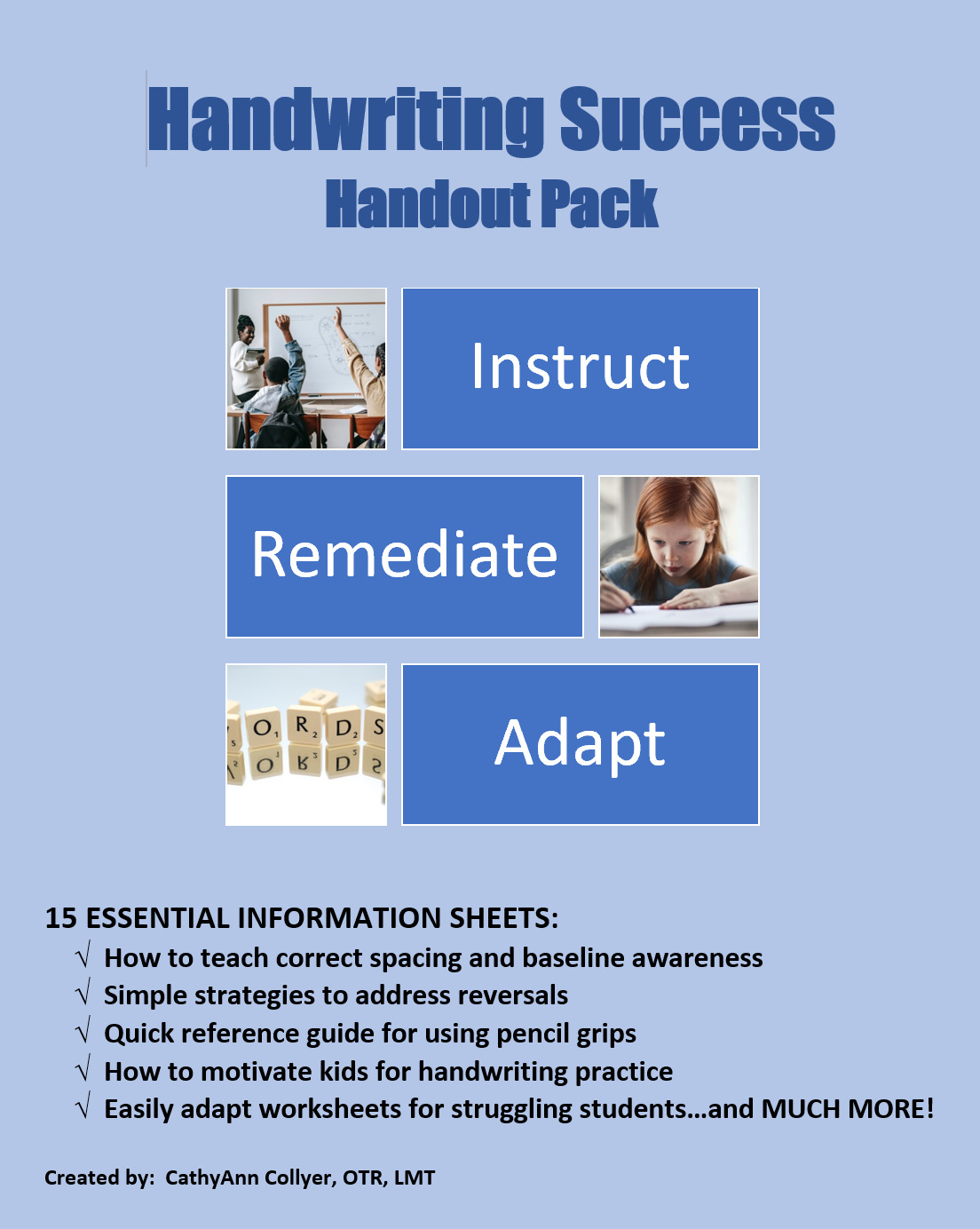Why Is Handwriting Important?

You may wonder why is handwriting important during this digital age. The idea that children do not need to be able to write legibly, that all important work will be done on a screen, has been repeatedly disproven in research studies. You only need to visit a Kindergarten-Grade 3 classroom to see for yourself.
You can download a FREE copy of this handout at the bottom of the post.
This handout is from the complete Handwriting Success Handout Packet.

Handwriting Success Handout Packet
WHY IS HANDWRITING IMPORTANT IN ELEMENTARY SCHOOL?
All children in grades K-3 spend a substantial amount of class time doing handwritten work.
Young children do not have the ability to use mature keyboarding skills necessary to generate a
volume of written work and mathematic calculations sufficient for learning.
How do we know this is true? Early elementary students with profound motor impairments require complex technology and intensive one-on-one training to develop foundational language skills without being able to write.
Kindergarteners are expected to write independently at the beginning of the school year to complete more complex academic assignments earlier in the school year than in the past. They need better skills as education is pushed earlier, not fewer skills.
BENEFITS OF TEACHING HANDWRITING
A developing brain learns more easily when exposed to the interplay of tactile, motor, and visual skills used in handwriting during instruction in language and math skills.
Handwriting improves fine motor skills, which are important for more than just writing. Handwriting also promotes the development of visual-motor integration and coordination as children learn to coordinate their eye movements with the movement of their hand. This skill is essential in many other areas of learning, such as sports, art projects, and self-care activities.
Handwriting is a form of communication and expression, providing physical records of thoughts that can be edited, reread, and shared with others. It is also a way for children to take pride in their work by producing neat work they are proud to share with family and friends.
Handwriting instruction also encourages phonemic awareness (the ability to hear and manipulate individual sounds in spoken words) that is essential in learning to read.
Thus, handwriting is an important skill for children to learn. It offers tangible physical benefits, helps build strong language and math skills, provides a form of communication and expression, and fosters pride in work created using the hand.
Read more about the research on handwriting here.
WHAT HAPPENS WHEN YOU DO NOT SKILLFULLY TEACH HANDWRITING?
There are several issues when handwriting is not explicitly taught. Of course the obvious ones are poor habits, incorrect letter formation and illegible handwriting.
But other issues may arise as well, such as:
- When children avoid handwriting, they are self-limiting opportunities to express thoughts and opinions and share their interests with others.
- Children who minimize the amount of handwriting they produce for an assignment decrease their practice of essential language skills such as spelling and grammar.
- A sense of hopelessness about handwriting can occur; children don’t see themselves as writers and see legible handwriting as an unattainable skill.
DOWNLOAD YOUR FREE HANDOUT HERE
>>>GRAB MY FREE COPY OF THE HANDOUT WHY IS HANDWRITING AN IMPORTANT SKILL HERE<<<

READ MORE ABOUT HANDWRITING
Activities to Improve Handwriting – Do you need to help your students with handwriting? The best way to get better is to practice. But it can be boring. These 30 activities make it fun and exciting.
Handwriting Lesson Plan – Are you in need of exciting and multi-sensory lessons to help your students maximize their handwriting instruction? Would you like a FREE lesson plan that allows them to practice their skills during the limited time window? Look no further! Here is an engaging, multicultural handwriting lesson plan which includes some worksheet sample pages for your convenience.
Handwriting and Intelligence – Have you heard the research that implies we typically learn more effectively by completing tasks ourselves, rather than merely observing someone else do it? This theory explains why babies and young children need to move around in order to develop their perceptual and motor systems. So then one must ask – if this is true, what’s the point of simply showing kids letters or numbers when teaching them how to identify them? Could there be a correlation between handwriting proficiency and intelligence as well?
Free Handwriting Activities – Need some practice activities? Check out this HUGE collection of freebies!
Interventions for Handwriting That Work – Are you observing students having difficulty with handwriting skills? It might be due to the growing utilization of technology at an earlier age, or possibly a shortage of fine motor skill free play during childhood. Even muscle weakness could contribute to illegible writing. Whatever the underlying cause is, Occupational Therapists, teachers and parents need successful interventions for student’s handwriting skills.


